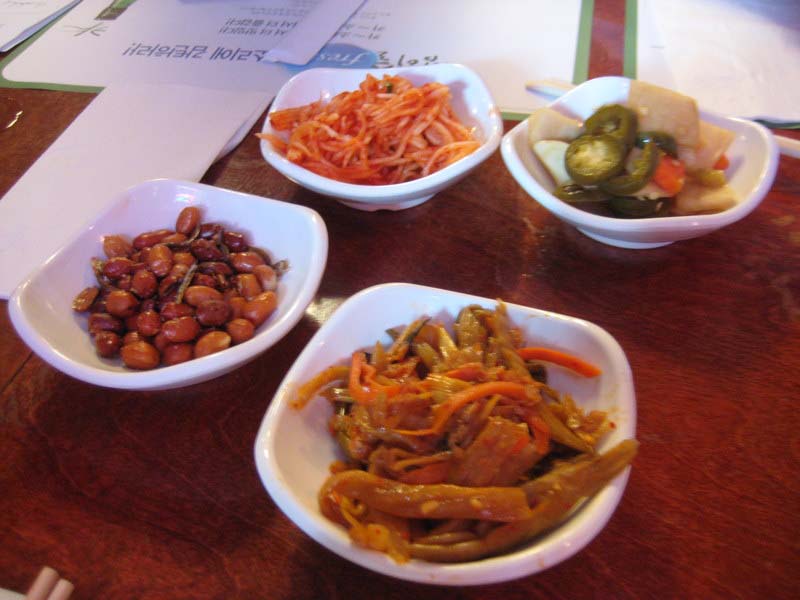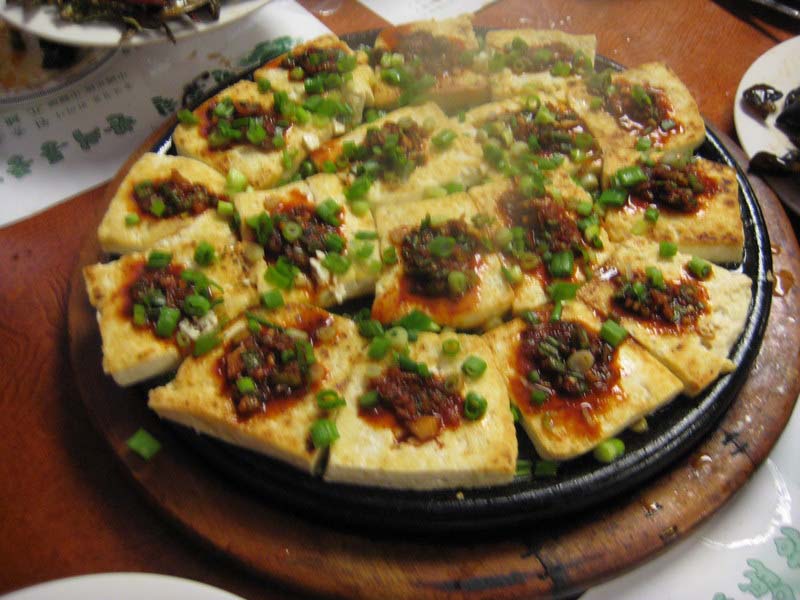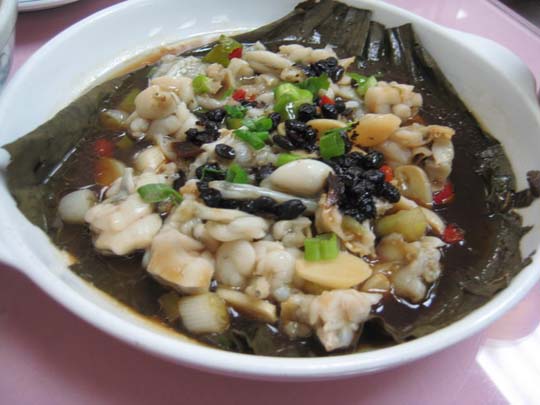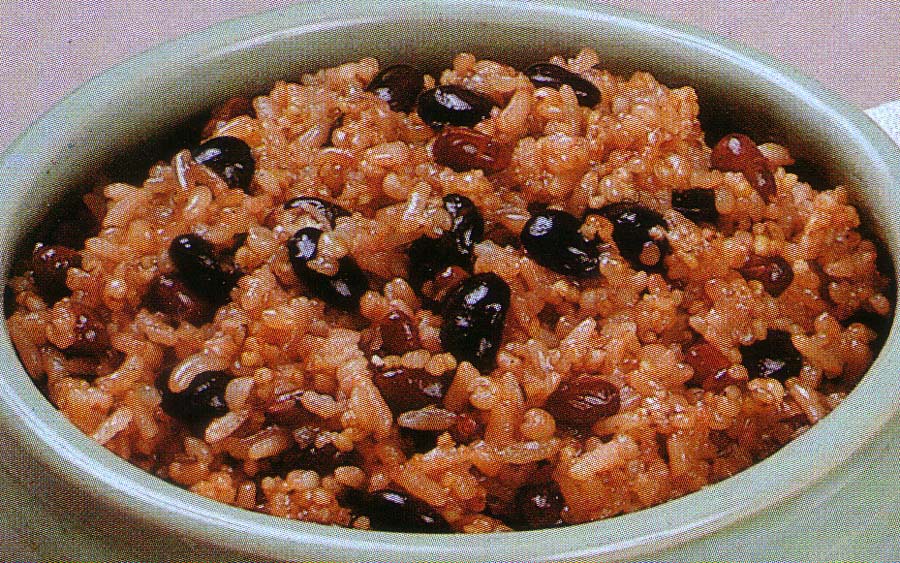
| What is Flavor and Fortune? |
| How do I subscribe? |
| How do I get past issues? |
| How do I advertise? |
| How do I contact the editor? |
Read 12923185 times
Connect me to:
| Home |
| Articles |
| Book reviews |
| Letters to the Editor |
| Newmans News and Notes |
| Recipes |
| Restaurant reviews |
| Article Index (all years, slow) |
| List of Article Years |
| Article Index (2025) |
| Article Index (last 2 years) |
| Things others say |
| Related Links |
| Log In... |
| Authors |
| Categories & Topics |
Chinese-Koreans
| by Jacqueline M. Newman |
Chinese Food in Asia (but not China, Hong Kong, or Taiwan)
Fall Volume: 2011 Issue: 18(3) page(s): 13, 14, 15, and 23
 Yanbian Chaoxianzu Autonomous Prefecture, seen here in Chinese, is also known as the Yanbian Korean Autonomous Prefecture. It is home to several million Chinese, forty percent of whom are of Korean heritage. Fifty-seven percent are Han Chinese, the other three percent are Manchu or Mongol minority peoples.
Yanbian Chaoxianzu Autonomous Prefecture, seen here in Chinese, is also known as the Yanbian Korean Autonomous Prefecture. It is home to several million Chinese, forty percent of whom are of Korean heritage. Fifty-seven percent are Han Chinese, the other three percent are Manchu or Mongol minority peoples.
This Autonomous Prefecture is the only minority prefecture in Jilin, one of the three northeastern Dongbei Provinces (Jilin, Liaoning, and Heilongjiang). It was founded in 1952, though Koreans came and settled here hundreds of years earlier. This forty-two thousand square mile prefecture is rich in natural and forest resources including many Chinese herbs such as ginseng and pilose antlers. About the size of North Dakota, it has a population more than forty times that northwestern state.
Korean ex-pats in this Jilin prefecture like many but not all their foods piquant and sour. Kimchi is a fine example of this taste combination which is most often but not always piquant. Actually, it did not get hot until the 18th century; before that kimchi was mostly sour.
Korean dishes and teas are popular in this Prefecture as are Chinese foods made with Korean tastes. People here like dried fish as a snack and grilled meats and tofu prepared over high flames at their main meals. They eat many hot pots, consume lots of noodles, and in summer drink chilled green teas, fruit teas, and root teas. Served warm or hot in winter and often with persimmon, they like their teas to include arrowroot and/or roasted barley juice.
 The staples of Chinese-Korean meals include kimchirice, pickled fish, pickled vegetables, dried fish, and many grain foods. One dish they adore is made with five grains including regular and glutinous rice, sorghum, millet, and black beans.
The staples of Chinese-Korean meals include kimchirice, pickled fish, pickled vegetables, dried fish, and many grain foods. One dish they adore is made with five grains including regular and glutinous rice, sorghum, millet, and black beans.
This Yanbian prefecture, the place where so very many Chinese-Koreans, or if yu prefer, Krean-Chinese live, is about one-quarter of the Jilin Province and is at its southern tip. Yanji is the name of its capital city, other large ones in the prefecture include Dunhua, Longjing, Hunchun, Tumen, and Helong. Korean-Chinese live throughout Jilin and many others live in the Liaoning and Heilongjiang provinces.
Not new to this area, Koreans actually began settling here as early as the 17th century. Large numbers came two centuries later because of famine in their homeland and many more came in the 20th century due to continued food shortages, occupation by the Japanese, and wanting to leave North Korea. They liked the fertile land, lovely hills, gorgeous landscapes, and the foods they could plant or raise here. They moved on one side of the Yalu and Tumen Rivers to separate themselves from North Korea and Russia. Here they could enjoy many frog dishes and other beloved dishes, even those flavored with or wrapped in lotus leaf.
A good number of Korean-Chinese living in Yanbian have built wooden homes with rice-straw roofs. They are proud to hold Chinese passports and consider themselves Korean-Chinese not simply Korean. Actually, they are the largest group of Koreans living outside of Korea and are proud of this fact.
 Chinese and westerners come to this region to see them, visit the Chang Bai Shan National Nature Preserve, ancient tombs at Longtou Mountain, the Korean Folk Village in the capital city’s suburbs, and the street markets featuring Korean and local fruits, nuts, and other foods. They come to eat special Chinese-Korean food and purchase beautiful Korean clothing, particularly for their children.
Chinese and westerners come to this region to see them, visit the Chang Bai Shan National Nature Preserve, ancient tombs at Longtou Mountain, the Korean Folk Village in the capital city’s suburbs, and the street markets featuring Korean and local fruits, nuts, and other foods. They come to eat special Chinese-Korean food and purchase beautiful Korean clothing, particularly for their children.
While in this prefecture, people view and try things not only Korean, but also Russian, Japanese, and Chinese. These are available in several Yanbian touristic locations, especially the Celestial Scenic Area south of the capital city. Other favorite purchases include ginseng, pilose antler, and marten, the three ‘treasures of China’s northeast.’
Korean-Chinese living here speak Mandarin Chinese and the Hamgyuan dialect of Korea and delight in many local noodle dishes, hot pots, and dumplings. Many of the latter are stuffed with mashed potatoes and spices then wrapped in a potato-flour dough. The exteriors of these dumplings are easily recognizable because they become transparent when boiled.
Visitors quickly learn to dip dumplings in local salty chili oil. With them they delight and devour many pickled foods, especially kimchi and suan cai. The latter is their local pickled cabbage. Both are served at virtually every meal in every restaurant and every home in Yanbian. In fact, almost every Korean-Chinese meal at home has these and more than one other pickled food set out and ready to eat. In restaurants, these dishes are set n the table only after patrons order a dish or a meal. If they do arrive on their table, they only need request them.. At breakfast, lunch, or dinner, hot and cold dishes, spicy or mild, hot or cold soups or all of the above can compliment their rice--the main meal staple, or the noodle dishes always served alongside the rice. Beverages are not served during most Korean-Chinese meals, though in very hot weather, a light and watery barley-tea is commonly served over ice.
Meals for guests at homes or in restaurants usually come with banchan or small plates that might include pickled vegetables, seasonal non-pickled ones, a pickled seafood or three, etc. It is interesting to note that these small plates are served in odd numbers.
Korean-Chinese eating means being polite and not lifting chopsticks or soup spoon until the eldest takes his or her first taste. When eating rice or a rice dish or a soup, a metal spoon is the utensil of choice; it always has a flat bowl. Here and in Korea, chopsticks are metal, too. Another item of politeness is never to lift the rice bowl off the surface of the table. These rules, though broken at breakfast, are always observed during dinner. Also, blowing one’s nose at any meal is a no-no even if the kimchi or another hot food tickles it.
Chinese-Korean meals have no courses. All dishes are placed on the table at the same time and eaten in any order desired. There are a few other rules. Two worth noting are never to talk with food in the mouth, and always to keep one’s lips together when chewing.
 There is a lot of chewing needed as grilled beef and grilled sea foods are served at many meals. So are cold buckwheat noodles with or without beef, cucumber, and hard-cooked egg. Sometimes this dish is topped with kimchi.
There is a lot of chewing needed as grilled beef and grilled sea foods are served at many meals. So are cold buckwheat noodles with or without beef, cucumber, and hard-cooked egg. Sometimes this dish is topped with kimchi.
Dongbei-Yanbian sausage is popular at main meals. It comes tightly banded with an animal-casing exterior and three different kinds of rice within. Thickened with beef blood and/or ground black beans, this and other dishes are served with a piquant seasoning for dipping. Another favorite, translated as bracken, is commonly recognized as pickled, plain, or stir-fried fiddlehead ferns.
Korean-Chinese celebrate all Chinese holidays and several Korean ones. They celebrate Lunar New Year at the same time as Chinese Spring Festival and at its New Year’s Eve meal, they eat many vegetable and seafood dishes. Not called ‘reunion dinner,’ it is the Korean Seol holiday dinner. They also celebrate a thanksgiving/harvest festival called Chusok or Seollal; it is on the 15th day of the 8th Lunar month. On that holiday, they eat rice cakes made with sesame seeds and chestnuts and a five-grain dish. 
Liutou, another holiday, is enjoyed on June 15th. This day it is common to carry food to the water’s edge, eat there, and wish to rid themselves of evil spirits by tossing them into the nearby water. On this and all holidays, a favorite snack is dried squid, a favorite rice dish made with meat and vegetables their pibimpap. It is always served with a spicy sauce as are lengmian, their cold wheat noodles. The latter has lots of spice in its beef broth. Another beloved soup is doufutang, also piquant and loaded with very thin slivers of dou fu. Any Korean-Chinese will suggest having grilled fish or grilled beef with this dish and an accompanying spicy sauce, too.
Many Korean-Chinese families make their own kimchi in earthenware vats. They store them on balconies or next to their kitchen door, and they make their own chili paste and store it there, too. Often family heirloom recipes, they are mighty proud of these recipes even though elders complain that younger folk simply purchase theirs. Maybe so, but everyone eats and enjoys theirs.
In Korea, Chinese food is thought fatty and oily. Those visiting this prefecture learn foods here are not all spicy, and certainly not fatty nor oily. They learn that locals adore zhajangmyon, a dish of wheat noodles and bean paste, that they love tangsuyuk, a sweet and sour beef made with a slice of apple-pear on top that is mixed with chili paste. Korean-Chinese love game, many raise these animals because hunting was frowned upon when they arrived and now is illegal.
The word for cooked rice is synonymous with the word for meal, and Korean-Chinese meals almost always have some even if they have a noodle dish or two. Most are proud they moved north, live well in China, and love to tell strangers they have many foods here to flavor their rice. With their lunar New Year holiday shared with the Chinese, Korean-Chinese enjoy many Korean and Chinese celebrations, eat a lot of rice cakes and much kimchi.
Taste some Chinese-Korean foods at restaurants reviewed in this issue, in previous and in future ones. Foods throughout the Yanbian Prefecture might be written in Hangeul–their Korean characters, in Chinese ideographs, or in English. One can sample some at the growing number of Korean-Chinese restaurants including Rifu reviewed by Michael Gray and Duck Hyang reviewed by the editor, both in the previous issue. Others will appear in future issues. For your pleasure, try the following Korean-Chinese recipes at home, too.
| Sausages, Korean-Chinese Style |
|---|
3 to 4 feet of beef intestine or sausage casing 2 Tablespoons coarse salt 1 cup cooked cold long grain rice 1 cup cooked cold glutinous rice 2 Tablespoons barley flour or tsampa 3 cloves garlic, peeled and minced 1/4 cup cooked black beans, mashed 1/2 teaspoon mixed ground white and black pepper 1 Tablespoon sesame oil 3 scallions, white part only, minced fine 1 cup beef blood 2 Tablespoons tomato paste 1 teaspoon mixed black and white sesame seeds Preparation: 1. Turn intestine inside out, and clean it removing anything attached to its sides. Dissolve the salt in three tablespoons of boiling water, add one quart of cold water, and mix well. Soak the intestines for two hours, and in the refrigerator. Then remove them from the water and turn them right-side out. 2. In a large bowl, mix both kinds of rice, the barley flour, and the mashed black beans. Add both white and black pepper, sesame oil, and the scallion pieces; and tie a knot at one end of the intestine or sausage casing. 3. Mix blood and the tomato paste and add this to the rice mixture before stuffing the intestine by machine or pushing it into the casing through a wide funnel. Do not pack too tightly or it will split when cooking. 4. Tie a knot or sew the other end of the casing closed, then put it into a large pan filled with cool water. Bring it to just below the boil, quickly reduce the heat to low and simmer the sausage for two hours. 5. Remove sausage and slice into one and a half-inch thick pieces. Put them rice-side down on a platter, sprinkle with the sesame seeds, and serve with a fresh or prepared chili sauce in a small dish on the side. |
| Chili Sauce, Korean-Chinese Style |
|---|
6 cloves garlic, peeled and coarsely minced 12 red chili peppers, seeded and coarsely chopped 1 Tablespoon chili pepper 3 Tablespoons sesame oil 3 Tablespoons soy oil or another vegetable oil 2 Tablespoons thin soy sauce Preparation: 1. Put all ingredients into a blender and run it on low until the mixture forms a thick paste. 2. Put into a glass jar, cover with plastic wrap secured with several rubber bands and store in a sunny place for half a day, then remove the cover, mix well, and refrigerate until needed. Note: This can be stored refrigerated for one to three months. |
| Potato and Kimchi Pancakes |
|---|
1 pound Idaho-type potatoes, peeled and grated 1/2 cup suan cai which is napa cabbage kimchi, minced fine 5 scallions, green part only, minced fine 3 Tablespoons potato flour 1 teaspoon coarse salt 1 Tablespoon thin soy sauce 3 cups oil for deep frying Preparation: 1. In a large bowl, mix the first six ingredients. 2. In wok or deep fry pan, heat the oil and take a ladle full of six mixed ingredients and carefully put it into the oil, flattening the top. Repeat until several are in the pan, not crowding any of them, and fry the pancakes until golden on one side, turn them over and fry on the other side until golden, then remove to a heat-proof platter and put into a 200 degree oven. Repeat until all are fried. Serve with the chili sauce on the side for dipping. |
| Five Grains |
|---|
1 cup glutinous rice, soaked four hours or more 1/2 cup sorghum, soaked four hours or more 1/2 cup dry black beans, soaked overnight 1 cup long-grain rice, soaked four hours or more 1/2 cup millet, soaked two hours or more 2 Tablespoons coarse salt 2 Tablespoons sesame oil Preparation: 1. Drain each grain, and set them aside separately. 2. Put rice, sorghum and black beans into a large heavy crock, cover with two inches of water, bring to the boil, reduce heat, cover the crock and simmer for one hour. 3. Add the millet and simmer uncovered for thirty minutes, then mix in the salt and sesame oil, and simmer until every grain and bean feels soft. Only stir this mixture once or twice during the entire cooking time. Then serve. |
| Bulgogi |
|---|
1 pound flank steak, trimmed of all fat, then cut into two-inch chopstick-size strips 1 pear-apple, peeled, cored, and grated 2 Tablespoons Chinese rice wine 2 cloves garlic, peeled and minced 2 Tablespoons thin soy sauce 1 Tablespoon sugar 1 Tablespoon sesame oil 1/4 teaspoon ground white pepper 1 onion, peeled and cut into two-inch chopstick-size strips 1 carrot, peeled and cut into two-inch chopstick-size strips 1/2 red pepper, seeded and cut into two-inch chopstick-size strips 1/2 green pepper and cut into two-inch chopstick-size strips 8 soft lettuce leaves, such as Boston lettuce Preparation: 1. Mix beef strips grated apple-pear, rice wine, minced garlic, soy sauce, sugar, sesame oil, and the ground pepper and toss well, cover, then refrigerate for one to two hours. Remove from the refrigerator and drain, if necessary. 2. Grill the meat until three-quarters cooked, remove from grill, and set on a platter. 3. Put onion, carrot, and red and green pepper strips on the same platter, and put this on the table; and put lettuce pieces in a small bowl next to them. 4. Every person should take one lettuce leaf and put a few strips of beef, and a few of the onion, carrot and red and green peppers on that piece of lettuce, then wrap it and it is ready to eat this beef and vegetables in its lettuce parcel. Note: This can be served with chili sauce, used as a dip, on the side. |

Copyright © 1994-2025 by ISACC, all rights reserved
Address
3 Jefferson Ferry Drive
S. Setauket NY 11720